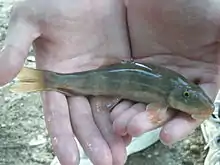Catostomus
Catostomus is a genus of fish belonging to the family Catostomidae, commonly known as suckers. This genus of fish usually lives in freshwater basins.[1] Most members of the genus are native to North America, but C. catostomus is also found in Russia.[2]
| Catostomus | |
|---|---|
 | |
| Catostomus clarkii | |
| Scientific classification | |
| Domain: | Eukaryota |
| Kingdom: | Animalia |
| Phylum: | Chordata |
| Class: | Actinopterygii |
| Order: | Cypriniformes |
| Family: | Catostomidae |
| Tribe: | Catostomini |
| Genus: | Catostomus Lesueur, 1817 |
| Type species | |
| Cyprinus catostomus J. R. Forster, 1773 | |
| Species | |
|
See text. | |
Characteristics
The members of this genus have nearly cylindrical bodies. They have large, horizontal mouths, and their lips are very much papillose. They have complete lateral lines. They have from 54 to 124 scales, seven to 17 dorsal rays, usually seven anal rays, and 20 to 44 thin, unbranched rakers on their first gill arches. Their gas bladders have two chambers.[2]
The young of many of the species in the genus have three dark grey blotches along their sides.[2]
Hybridization
Catostomus from different species of the genus are known to readily hybridize with each other.[2] The fish was used as a study object by biologists, revealing that fish hybridization can vary greatly from place to place. Although different species of this fish are reproductively isolated under normal circumstances,this isolating barrier disappears to a certain extent as the environment changes. In addition, in areas where backcross and hybridization were widespread, the scientists found offspring of recombinant hybrids with new ecological characteristics that made them more adapted to the local environment and even more competitive with native species. Hybridization between different species of Catostomus fish occurs on a large scale, which means that many different environmental factors are involved in these geographic areas. This pattern of hybridization is also an effective mechanism for species self-protection. Although the hybrid form of Catostomus fish breaks the common reproductive isolation between species, related research results can help to lead the protection of the waters where Catostomus fish live.[3]
Species
Currently, 28 recognized species are in this genus:[4][5]
- Catostomus ardens (D. S. Jordan & C. H. Gilbert, 1881) (Utah sucker)
- Catostomus bernardini (Girard, 1856) (Yaqui sucker)
- Catostomus bondi (G. R. Smith, J. D. Stewart & N. E. Carpenter, 2013)[5]
- Catostomus cahita (Siebert & W. L. Minckley, 1986) (Cahita sucker)
- Catostomus catostomus (J. R. Forster, 1773)
- Catostomus catostomus catostomus (J. R. Forster, 1773) (Longnose sucker)
- †C. c. cristatus (Cope, 1883)
- C. c. lacustris (Bajkov, 1927) (Jasper longnose sucker)
- Catostomus clarkii (S. F. Baird & Girard, 1854) (Desert sucker)
- C. c. intermedius (Tanner, 1942) (White River desert sucker)
- C. c. utahensis (Virgin River desert sucker)
- C. c. unnamed (Meadow Valley Wash desert sucker)
- Catostomus columbianus (C. H. Eigenmann & R. S. Eigenmann, 1893) (Bridgelip sucker)
- Catostomus commersonii (Lacépède, 1803) (White sucker)
- Catostomus conchos (Meek, 1902)
- Catostomus discobolus (Cope, 1871)
- C. d. discobolus (Cope, 1871) (Bluehead sucker)
- C. d. jarrovii (Cope, 1874) (Zuni bluehead sucker)
- Catostomus fumeiventris (R. R. Miller, 1973) (Owens sucker)
- Catostomus insignis (S. F. Baird & Girard, 1854) (Sonora sucker)
- Catostomus latipinnis (S. F. Baird & Girard, 1853) (flannelmouth sucker)
- Catostomus leopoldi (Siebert & W. L. Minckley, 1986) (Bavispe sucker)
- Catostomus macrocheilus (Girard, 1856) (largescale sucker)
- Catostomus microps (Rutter, 1908) (Modoc sucker)
- Catostomus nebuliferus (Garman, 1881) (Nazas sucker)
- Catostomus occidentalis (Ayres, 1854)
- Catostomus platyrhynchus (Cope, 1874) (Mountain sucker)
- Catostomus plebeius (S. F. Baird & Girard, 1854) (Rio Grande sucker)
- Catostomus rimiculus (C. H. Gilbert & Snyder, 1898) (Klamath smallscale sucker)
- Catostomus santaanae (Snyder, 1908) (Santa Ana sucker)
- Catostomus snyderi (C. H. Gilbert, 1898) (Klamath largescale sucker)
- Catostomus tahoensis (T. N. Gill & D. S. Jordan, 1878) (Tahoe sucker)
- Catostomus tsiltcoosensis (Evermann & Meek, 1898) (Tyee sucker)
- Catostomus utawana (F. W. Mather, 1886) (Summer sucker)
- Catostomus warnerensis (Snyder, 1908) (Warner sucker)
- Catostomus wigginsi (Herre & Brock, 1936) (Opata sucker)
There is also one candidate species:
- Wall Canyon sucker (C. L. Hubbs & R. R. Miller, 1934), which is sister to Warner sucker.[6]
References
- Bangs, Max R.; Douglas, Marlis R.; Mussmann, Steven M.; Douglas, Michael E. (2018-06-07). "Unraveling historical introgression and resolving phylogenetic discord within Catostomus (Osteichthys: Catostomidae)". BMC Evolutionary Biology. 18 (1). doi:10.1186/s12862-018-1197-y. ISSN 1471-2148.
- Page, Lawrence M.; Burr, Brooks M. (2011). Peterson Field Guide to Freshwater Fishes of North America North of Mexico. Houghton Mifflin Harcourt. p. 308. ISBN 0547242069.
- Mandeville, Elizabeth G.; Parchman, Thomas L.; McDonald, David B.; Buerkle, C. Alex (2015-03-23). "Highly variable reproductive isolation among pairs of Catostomus species". Molecular Ecology. 24 (8): 1856–1872. doi:10.1111/mec.13118. ISSN 0962-1083.
- Froese, Rainer and Pauly, Daniel, eds. (2013). Species of Catostomus in FishBase. February 2013 version.
- Smith, G.R., Stewart, J.D. & Carpenter, N.E. (2013): Fossil and recent mountain suckers, Pantosteus, and significance of introgression in catostomin fishes of Western United States. Occasional Papers of the Museum of Zoology University of Michigan, 743: 1-59.
- Campbell, Matthew A.; Badger, Mary E.; Buckmaster, Nick; Starostka, Andrew B.; Hawks, Travis; Finger, Amanda J. (2023). "Molecular phylogenetic and population genetic relationships of a putative species of sucker (Catostomus sp.) from Surprise Valley in the Great Basin, USA". Transactions of the American Fisheries Society. 152 (3): 273–286. doi:10.1002/tafs.10407. ISSN 0002-8487.